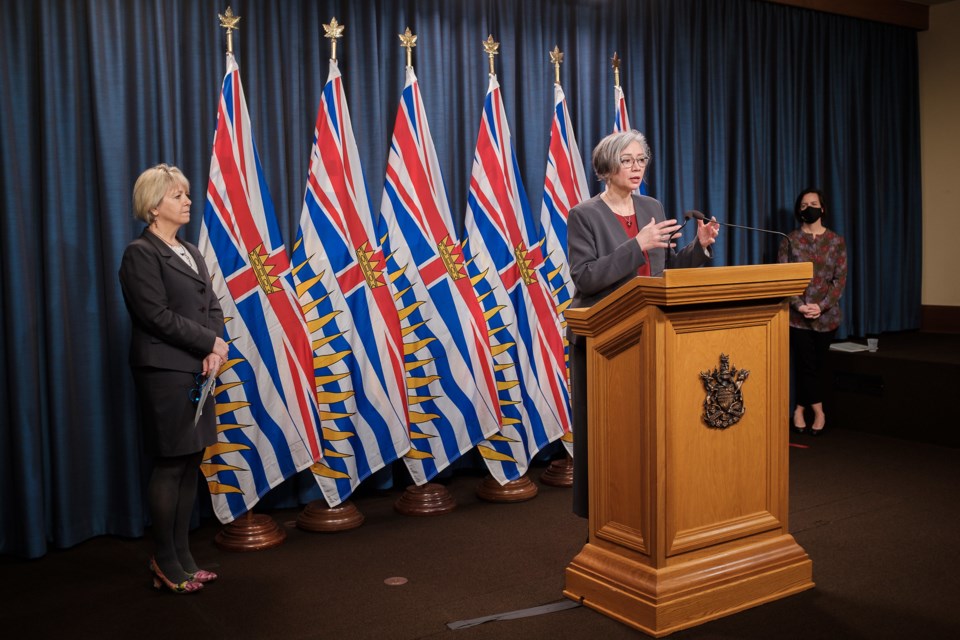Don’t expect school closures in B.C. in the face of growing concerns over new COVID-19 variants.
That message was delivered loud and clear by B.C. Education Minister Jennifer Whiteside and provincial health officer Dr. Bonnie Henry at a media briefing held Feb. 4 to announce new health and safety guidelines for B.C. schools.
“Schools are at the heart of our neighbourhoods and communities, and they are the best places for students to learn and develop their abilities, their knowledge, their skills. There simply is no substitute for in-class learning,” Whiteside said.
Whiteside cited a September 2020 report from the B.C. Centre for Disease Control that found the closure of schools last spring had a “profound and dislocating impact” on the lives of many students – and that, she said, is why the government made it a priority to open schools in September.
“Thanks to the hard work of education professionals, the vast majority of our students are attending school and receiving full-time face-to-face instruction,” she said.
“I’ve heard from many families that it means a lot for their children to join their friends and teachers in the classroom, and that’s why keeping schools safe and open remains a priority for our government.”
Henry acknowledged COVID-19 has proven to be a “challenging foe” for B.C., and the education system has experienced that challenge at all levels.
“We know that in-class learning, however, and the opportunity for students to be in school is so, so important, not just for their education but also for mental, physical and emotional wellness, and it is such an important part of growth and development for our young people,” she said.
Henry said surveys show that it was “very disruptive” for students, families and educators when in-person learning was suspended last year.
“These can have lasting effects throughout a lifespan,” she said.
TRANSMISSION LOW IN SCHOOLS
Both Whiteside and Henry reiterated the message that COVID-19 exposures in schools reflect what’s happening in the communities around them and that transmission within schools has remained low.
Henry acknowledged the increased concern over the arrival of the new, more transmissible, COVID-19 variants, including the B.1.1.7 variant of concern (a.k.a. the U.K. variant).
She noted a recent case in the Fraser Health region connected to Garibaldi Secondary School in Maple Ridge, where 81 students and eight teachers were tested after one person connected to the school tested positive for COVID-19 and had been a close contact of someone with the B.1.1.7 variant.
That initial person did, in fact, test positive for the B.1.1.7 variant.
Henry said testing on that person’s school contacts was done “out of caution,” and the results came back negative across the board. Although rapid testing turned up one positive case, Henry said followup testing using the more accurate PCR method showed that to be a false positive.
“We have had nobody who was transmitted from that person,” she said, noting that shows the safety measures in schools are working to prevent transmission of the virus.
REGIONAL APPROACH UNLIKELY
Teachers’ union local presidents from the Fraser Health region (which stretches from Burnaby to Boston Bar) had lobbied the province in January for improved health and safety protocols in the region’s schools – which, particularly in Surrey, have been among the hardest-hit by the pandemic in B.C.
As part of the newly announced health and safety guidelines, the province is allocating $900,000 to set up six regional rapid response teams – one for each health authority and one for independent schools – that will include representatives from both schools and provincial health staff.
Those teams will be responsible for helping to improve communications with school districts and families, to conduct inspections in schools and ensure compliance with COVID-19 protocols, and to do followup after any “significant” exposure events or in-school transmission.
But it looks unlikely that any region-specific action will be taken by the province.
Asked whether there was a likelihood of the province taking a regional approach to its COVID-19 response, Whiteside replied: “We have worked very hard throughout the course of this pandemic to be consistent in the approach. We know that what happens in schools mirrors, of course, what’s happening in our communities, and we have seen, again, very low rates of transmission in schools.
“We know that trying to maintain a very high standard of implementation of our school safety plans across all of the districts is very critical to keeping schools safe. That approach, of consistency and maintaining strong provincial standards, has been very important.”
Follow Julie MacLellan on Twitter @juliemaclellan.
Email Julie, [email protected].



